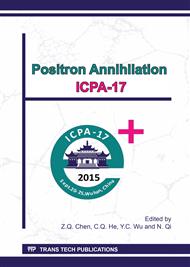[1]
D. K. Tappin, D. J. Bacon, C. A. English, et al. The Characterization of Displacement-Cascade Collapse in Ni-Cr-Fe Alloys, J. Nucl. Mater. 205 (1993) 92-97.
DOI: 10.1016/0022-3115(93)90075-a
Google Scholar
[2]
A. Etienne, M. Hernandez-Mayoral, C. Genevois, et al. Dislocation loop evolution under ion irradiation in austenitic stainless steels, J. Nucl. Mater. 400 (2010) 56-63.
DOI: 10.1016/j.jnucmat.2010.02.009
Google Scholar
[3]
H. F. Huang, J. J. Li, D. H. Li, et al. TEM, XRD and nanoindentation characterization of Xenon ion irradiation damage in austenitic stainless steels, J. Nucl. Mater. 454 (2014) 168-172.
DOI: 10.1016/j.jnucmat.2014.07.033
Google Scholar
[4]
K. Vortler, N. Juslin, G. Bonny, et al. The effect of prolonged irradiation on defect production and ordering in Fe-Cr and Fe-Ni alloys, J Phys-Condens Mat. 23 (2011) 355007.
DOI: 10.1088/0953-8984/23/35/355007
Google Scholar
[5]
S. J. Zinkle, N. M. Ghoniem Prospects for accelerated development of high performance structural materials, J. Nucl. Mater. 417 (2011) 2-8.
Google Scholar
[6]
S. Y. Zhu, Y. N. Zheng, P. Ahmat, et al. Temperature and dose dependences of radiation damage in modified stainless steel, J. Nucl. Mater. 343 (2005) 325-329.
DOI: 10.1016/j.jnucmat.2004.11.020
Google Scholar
[7]
A. P. Druzhkov, D. A. Perminov, A. E. Davletshin The effect of alloying elements on the vacancy defect evolution in electron-irradiated austenitic Fe-Ni alloys studied by positron annihilation, J. Nucl. Mater. 384 (2009) 56-60.
DOI: 10.1016/j.jnucmat.2008.10.002
Google Scholar
[8]
Q. Xu, H. Watanabe, N. Yoshida Microstructural evolution in Fe-Cr-Ni alloy irradiated with Ni ion under varying temperature, J. Nucl. Mater. 233 (1996) 1057-1061.
DOI: 10.1016/s0022-3115(96)00118-3
Google Scholar
[9]
A. D. Brailsford, R. Bullough Citation Classic - the Rate Theory of Swelling Due to Void Growth in Irradiated Metals, Cc/Eng Tech Appl Sci. (1982) 22-22.
Google Scholar
[10]
T. Yoshiie, X. Z. Cao, K. Sato, et al. Point defect processes during incubation period of void growth in austenitic stainless steels, Ti-modified 316SS, J. Nucl. Mater. 417 (2011) 968-971.
DOI: 10.1016/j.jnucmat.2010.12.189
Google Scholar
[11]
M. Eldrup, B. N. Singh Studies of defects and defect agglomerates by positron annihilation spectroscopy, J. Nucl. Mater. 251 (1997) 132-138.
DOI: 10.1016/s0022-3115(97)00221-3
Google Scholar
[12]
M. Lambrecht, A. Almazouzi Positron annihilation study of neutron irradiated model alloys and of a reactor pressure vessel steel, J. Nucl. Mater. 385 (2009) 334-338.
DOI: 10.1016/j.jnucmat.2008.12.020
Google Scholar
[13]
J. F. Ziegler, J. P. Biersack, U. Littmark The Stopping and Range of Ions in solids, Pergamon, New York, , (1985) http: /www. srim. org.
Google Scholar
[14]
H. P. Zhu, Z. G. Wang, X. Gao, et al. Positron annihilation Doppler broadening spectroscopy study on Fe-ion irradiated NHS steel, Nucl Instrum Meth B. 344 (2015) 5-10.
Google Scholar
[15]
E. Lu, X. Cao, S. Jin, et al. Investigation of vacancy-type defects in helium irradiated FeCrNi alloy by slow positron beam, J. Nucl. Mater. 458 (2015) 240-244.
DOI: 10.1016/j.jnucmat.2014.12.070
Google Scholar
[16]
B. Y. Wang, Y. Y. Ma, P. Wang, et al. Development and application of the intense slow positron beam at IHEP, Chinese Phys C. 32 (2008) 156-159.
Google Scholar
[17]
Y. Y. Ma, S. L. Pei, X. Z. Cao, et al. Design of a pulsing system for Beijing intense slow positron beam, High Energ Phys Nuc. 30 (2006) 166-170.
Google Scholar
[18]
Q. Xu, K. Sato, X. Z. Cao, et al. Interaction of deuterium with vacancies induced by ion irradiation in W, Nucl. Instr. Meth. Phys. Res. B. 315 (2013) 146-148.
Google Scholar
[19]
H. Huomo, A. Vehanen, M. Bentzon, et al. Positron diffusion in Mo: The role of epithermal positrons, Phys. Rev. B. 35 (1987) 8252-8255.
DOI: 10.1103/physrevb.35.8252
Google Scholar
[20]
A. v. Veen, H. Schut, J. d. Vries, et al. Analysis of positron profiling data by means of 'VEPFIT', 218 (1991) 171-198.
DOI: 10.1063/1.40182
Google Scholar
[21]
C. Dimitrov, M. Tenti, O. Dimitrov Resistivity Recovery in Austenitic Fe-Cr-Ni Alloys Neutron-Irradiated at 23-K, J Phys F Met Phys. 11 (1981) 753-765.
DOI: 10.1088/0305-4608/11/4/009
Google Scholar
[22]
A. P. Druzhkov, D. A. Perminov, V. L. Arbuzov The effect of carbon on the evolution of vacancy defects in electron-irradiated nickel studied by positron annihilation, J. Nucl. Mater. 434 (2013) 198-202.
DOI: 10.1016/j.jnucmat.2012.11.044
Google Scholar


